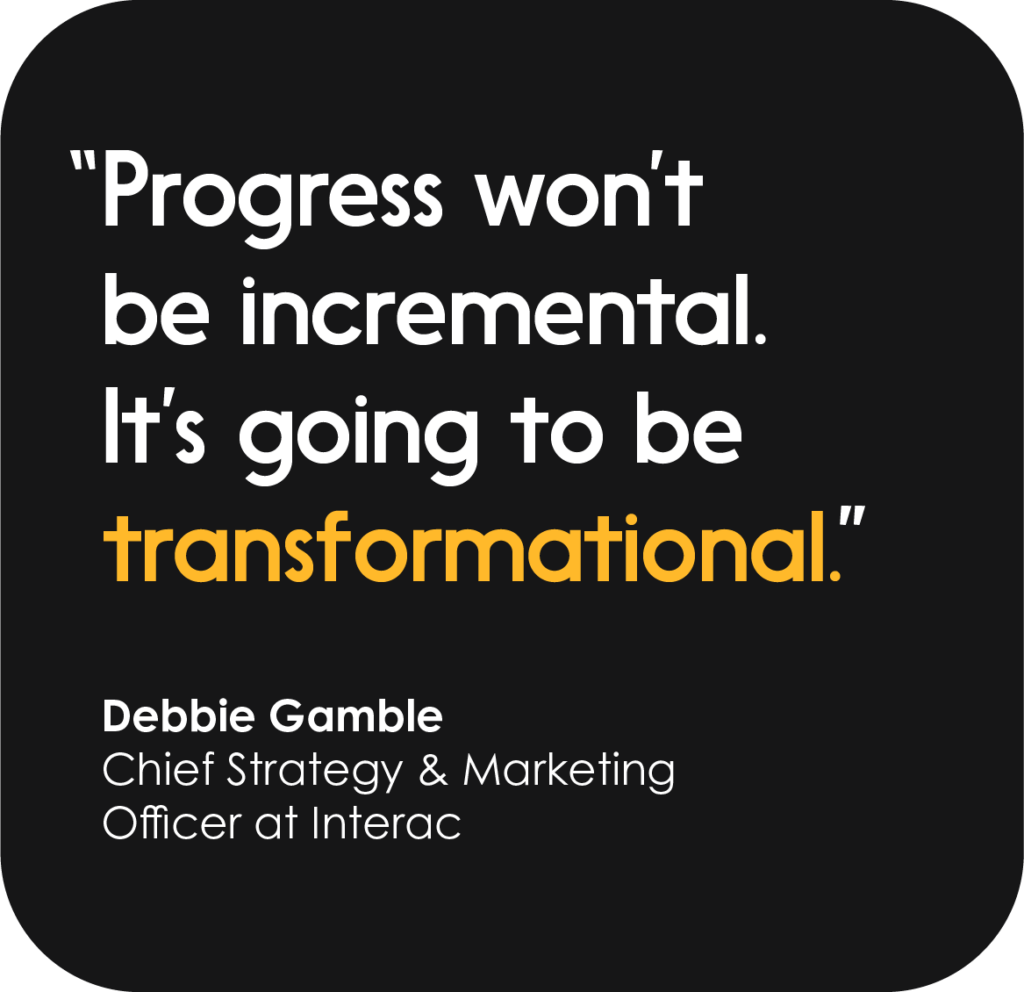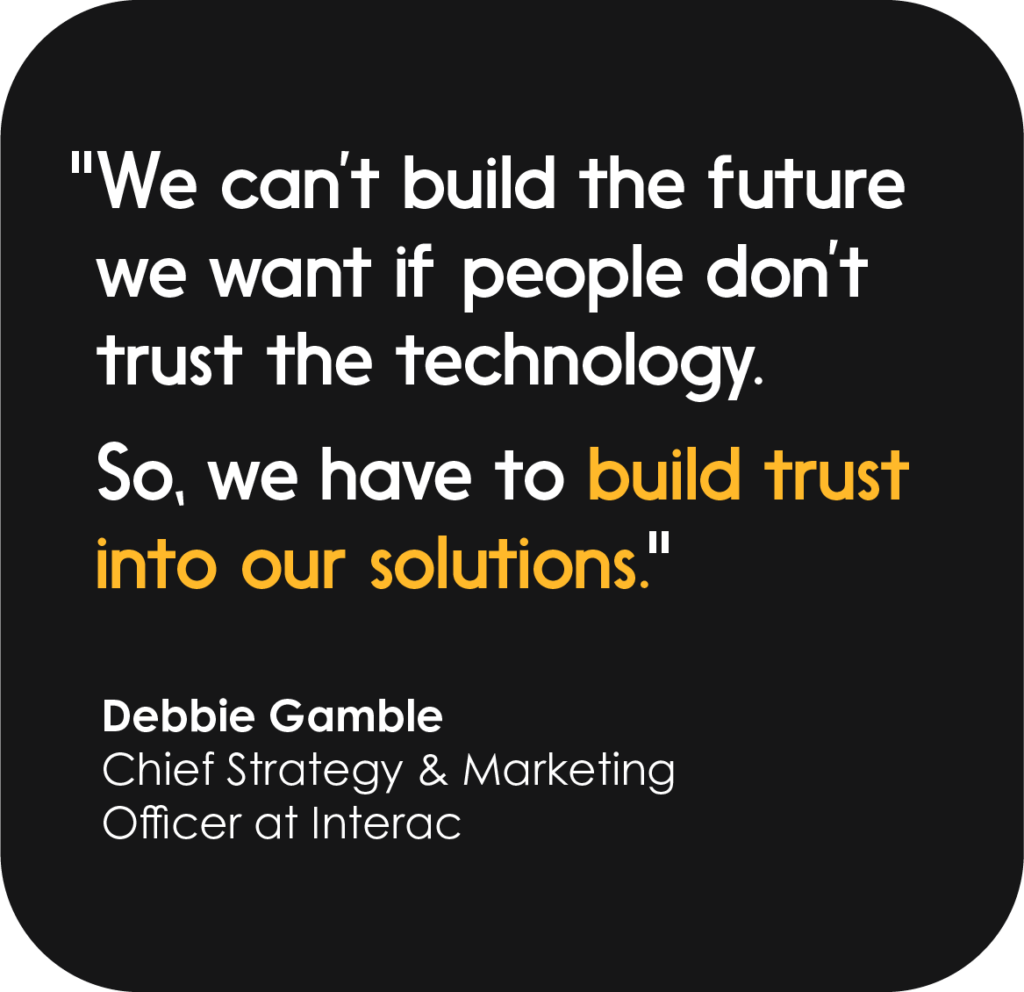At Interac we’re celebrating our 40th anniversary during a time of transformation — not just for Canada’s economy, but the world’s.
The global economy is in a state of rapid change, driven by demand for payments modernization, digital identity solutions and seamless financial transactions. Instant payments and digital wallets are becoming the global standard. For the foreseeable future, financial technology will be a core driver of economic growth almost everywhere.
For Canada, fully embracing digitalization will help bring vast economic benefits and unlock the untapped potential of small and medium-sized businesses — which form the backbone of the economy — as well as large enterprises.
But how should we move forward? What principles and priorities should guide us as we build the new digital economy?
To mark our milestone anniversary, Interac convened leading Canadian industry experts to help envision a future of digital prosperity. Our conversations with them helped reaffirm that our plans at Interac represent steps (and leaps) forward in the right direction. I’m eager to share some thoughts from our discussions below that will help illuminate the path ahead as we lead the Canadian economy toward exciting new possibilities.
How ready is Canada for a faster digital economy?
Other countries have beaten us to the punch regarding some aspects of modernizing and digitizing their economies; Brazil and India, for example, are among those that are further along with integrating instant payments into daily life. But as Interac CEO Jeremy Wilmot has said, Canada is well equipped to not only catch up but to “leapfrog” our peer nations (while learning from their experiences).
First, we’re a dynamic and growing country — as David Coletto, Founder, Chair and CEO of the polling firm Abacus Data, said in conversation with Interac, “I see diversity as Canada’s strength today and it will continue to be Canada’s strength.”
Second, in Canada we have the necessary infrastructure to accelerate our digital transformation. We already have real-time capabilities behind Interac e-Transfer that make the exchange of funds between recipients instant. And we’re on the cusp of advances that will help make the flow of money and data even more efficient, empower workers, and enhance Canada’s productivity (which, as I’ve noted before, is lagging when compared to our global peers). These opportunities will drive productivity-boosting innovation, and help Canada compete on the global stage.
It will also strengthen the businesses that drive our economy — including Canadian small businesses and startups, which represent our third big advantage. Manjit Minhas, CEO and Co-founder of Minhas Brewery, Distillery and Winery, said Canada’s entrepreneurs have the innovative spirit that will enable them to thrive. “We’re all discovering how powerful small and medium businesses are in this country, and really how flexible and adaptable they are. They’re really great at new ideas, they’re really great at meeting market demands, finding out what customers’ problems are and solving them, and meeting customer needs really quickly. I think COVID really proved that to those who had any doubt.”
I know from long personal experience working with tech startups that this is true.
Now, in order to move forward with this transformation and achieve global leadership, we need to improve access to digital services for businesses and consumers. Canada will have to focus on two critical areas: real-time account-to-account payments, and fraud prevention reinforced by next-generation verification solutions.

Payment modernization that brings real-time, account-to-account transactions will help businesses in untold ways. Progress won’t be incremental. It’s going to be transformational.
As Scott McDonald — President of The Future of Money conference — said in the course of our conversations, “[the] Real-Time Rail (RTR) is fantastic and welcome news. Many people won’t even know that there was something wrong in the old system. But they certainly won’t want to go back to it once they experience the new.”
Scott imagined the possibilities of real-time, account-to-account payments embedded within a secure ecosystem: “Merchants will know their customers’ needs even before they arise, with ledgers capturing a lot more than simply transaction records, but also deep profiles and long-term spending patterns. Your customers will spend more time shopping and less time paying, and will have consumer experiences that don’t exist today. It’s going to provide experiences for end users that are going to delight them.”
Scott also noted that an accelerated digital economy could unlock “a level of personalization hitherto impossible.” Personalization in digital services will help us cater to a multitude of needs and preferences, an important capability in a country that’s already diverse and becoming moreso.
Looking at instant, account-to-account payments through an entrepreneur’s lens, Manjit said fast payments help SMBs grow. “Payment delays hinder so much of entrepreneurs’ growth, not to mention their understanding of their buying power and cash flow, and ultimately their ability to take risks. That’s why timeliness is super important.”
To work toward bringing real-time, account-to-account payments to life, we’re continuing to work with Payments Canada and its other delivery partners to advance the RTR project. As I write, there’s a renewed energy around RTR; we partners are all rallying around a collaborative approach .
Earning trust through security and fraud prevention
As much as the digital realm is brimming with potential, there can also be risks. Digital fraud has been on the rise in Canada. In 2023 alone, Canadians reported losing $567 million to fraud, according to the Canadian Anti-Fraud Centre (CAFC) and the Royal Canadian Mounted Police (RCMP). However, with an estimated 90-95% of fraud cases going unreported, the actual losses could be significantly higher, ranging from $5.7 billion to $11.3 billion. David Coletto said that his firm’s polls show that when asked whether they see the future as being more likely to bring threats or opportunities, Canadians say threats — “by a two-to-one margin.”
“On the one hand, I think people have come to really value what digital technology has meant for their lives, the convenience that it delivers, the amount of information that they now have access to, the ability to get things done,” he said. But “Canadians are not sure who to believe and who to trust.”

We have to change that. The organizations and businesses that shape daily life need to work harder to earn Canadians’ trust. I agreed with Ann Cavoukian, Founder and CEO, Global Privacy and Security by Design Centre, former three-term privacy commissioner of Ontario, when she said, “Trust is essential to society, to individuals — but it is fleeting right now,” and the pitfalls of using existing digital technology have contributed to the trust deficit that a lot of Canadians understandably have around newer technologies.
We can’t build the future we want if people don’t trust the technology. So, we have to build trust into our solutions. And as Ann said, it’s not enough to tell users that their transactions are safe, “it has to be substantiated” in a concrete way.
At Interac we’re committed to strengthening security with next-generation verification and fraud prevention measures. We believe these not only safeguard business transactions, but also build greater consumer trust in the digital environment, which is crucial for long-term growth. We introduced Interac Verified last year because we believe effective fraud prevention starts with digital verification, which can provide transparency around who transfers money, including certainty about the recipient.
More broadly, Interac is uniquely positioned to lead on fraud prevention and detection in the Canadian financial system, especially as we move towards real-time payments. Our central place in the economy in the middle of billions of day-to-day transactions gives us the abilityto identify patterns and take steps to help prevent likely fraud. We’re leveraging that position to protect Canadians and businesses. Reinforcing our fraud-fighting capabilities is a priority for the years ahead — for example, as my colleague Jeremy has said, “we’re going to ensure there will be robust fraud protections in place on day one of the RTR.”
Our vision for the future
We believe Canadians need a modern and trusted financial system to fully participate in the 21st-century digital economy. Jeremy calls this guiding vision “digital prosperity.” It means enabling secure, seamless transactions for Canadians in a fully digital world, while delivering tangible benefits to businesses of all sizes, such as improving operational efficiency, expanding customer reach and fostering long-term growth. It means putting the benefits of the digital economy within everyone’s reach.
To achieve this vision, we’re leveraging emerging technologies to reshape how Canadians, businesses and other organizations interact with each other — so they can do it faster, but with stronger protection baked in. Our ultimate goal is to help raise the standard of living across the country and help our businesses grow and compete globally. It’s about making Canada a leader on the world stage.
I hope you’ll agree that’s a worthwhile vision for our next 40 years.
Gain valuable insights into trends shaping the Canadian economy with our Everyday Trust series




